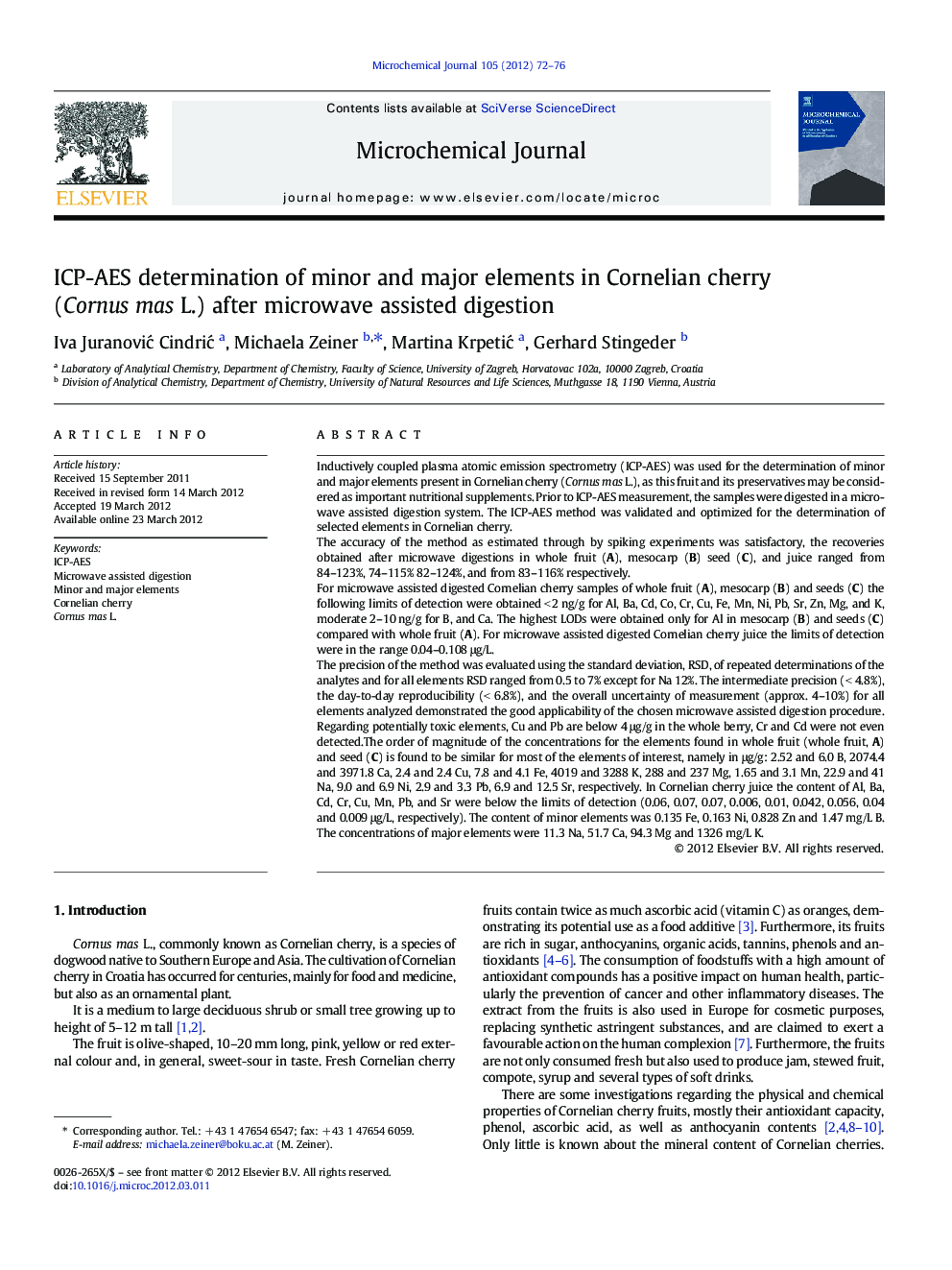| Article ID | Journal | Published Year | Pages | File Type |
|---|---|---|---|---|
| 1227895 | Microchemical Journal | 2012 | 5 Pages |
Inductively coupled plasma atomic emission spectrometry (ICP-AES) was used for the determination of minor and major elements present in Cornelian cherry (Cornus mas L.), as this fruit and its preservatives may be considered as important nutritional supplements. Prior to ICP-AES measurement, the samples were digested in a microwave assisted digestion system. The ICP-AES method was validated and optimized for the determination of selected elements in Cornelian cherry.The accuracy of the method as estimated through by spiking experiments was satisfactory, the recoveries obtained after microwave digestions in whole fruit (A), mesocarp (B) seed (C), and juice ranged from 84–123%, 74–115% 82–124%, and from 83–116% respectively.For microwave assisted digested Cornelian cherry samples of whole fruit (A), mesocarp (B) and seeds (C) the following limits of detection were obtained < 2 ng/g for Al, Ba, Cd, Co, Cr, Cu, Fe, Mn, Ni, Pb, Sr, Zn, Mg, and K, moderate 2–10 ng/g for B, and Ca. The highest LODs were obtained only for Al in mesocarp (B) and seeds (C) compared with whole fruit (A). For microwave assisted digested Cornelian cherry juice the limits of detection were in the range 0.04–0.108 μg/L.The precision of the method was evaluated using the standard deviation, RSD, of repeated determinations of the analytes and for all elements RSD ranged from 0.5 to 7% except for Na 12%. The intermediate precision (< 4.8%), the day-to-day reproducibility (< 6.8%), and the overall uncertainty of measurement (approx. 4–10%) for all elements analyzed demonstrated the good applicability of the chosen microwave assisted digestion procedure.Regarding potentially toxic elements, Cu and Pb are below 4 μg/g in the whole berry, Cr and Cd were not even detected.The order of magnitude of the concentrations for the elements found in whole fruit (whole fruit, A) and seed (C) is found to be similar for most of the elements of interest, namely in μg/g: 2.52 and 6.0 B, 2074.4 and 3971.8 Ca, 2.4 and 2.4 Cu, 7.8 and 4.1 Fe, 4019 and 3288 K, 288 and 237 Mg, 1.65 and 3.1 Mn, 22.9 and 41 Na, 9.0 and 6.9 Ni, 2.9 and 3.3 Pb, 6.9 and 12.5 Sr, respectively. In Cornelian cherry juice the content of Al, Ba, Cd, Cr, Cu, Mn, Pb, and Sr were below the limits of detection (0.06, 0.07, 0.07, 0.006, 0.01, 0.042, 0.056, 0.04 and 0.009 μg/L, respectively). The content of minor elements was 0.135 Fe, 0.163 Ni, 0.828 Zn and 1.47 mg/L B. The concentrations of major elements were 11.3 Na, 51.7 Ca, 94.3 Mg and 1326 mg/L K.
► Popularization of Cornelian cherry and the potential of European cultivars as a new promising fruit species. ► The elemental content of berries influences the quality of fruit, including organoleptic characteristics and stability. ► Metal concentrations were determined using ICP-AES. ► The knowledge of the mineral contents of berries is important from the toxicological point of view. ► This study is important confirms the importance of Cornelian cherry as nutritional supplement.
